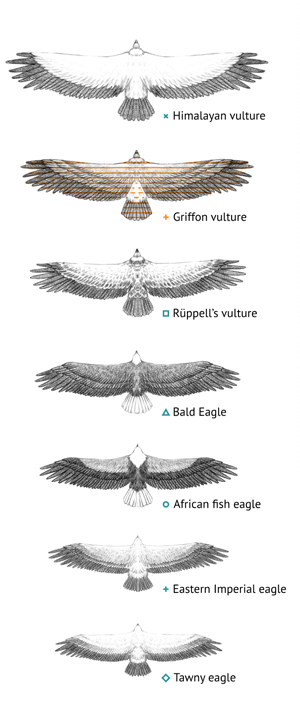Griffon vulture
Causses – France
Vultures are iconic species, amazing flyers and play an important role at the end of
the feeding chains. Traditionally, these birds were prospecting for carcasses of sheeps
and other mammals, an unpredictable resource. But the modification of the agricultural practices and the transformation of the landscape threatened their survival.
Conservationists have placed ossuaries to offer feeding spots but vultures could become too dependent on them. There is therefore a need for fine-scale information on the habitat usage of these birds. In the South of France bio-logging studies are here to deliver precious data for protecting the birds and their ecosystems.
GPS and accelerometry
Vultures nest on inaccessible cliffs in wild canyons, are often on the wing at altitudes that can reach up to several thousands meters and are not particularly fond of human presence. A bio-logger is thus the best way to access information. Here, a GPS will record precise locations (with errors ranging 1-5m). altitude and instantaneous speed as a function of time. The GPS can be coupled with an accelerometer that gives even more fine-scale information along 3 axes on the posture and dynamic movements of the birds. A rechargeable battery linked to a miniature solar panel will allow recordings to go on for extended periods of time.
Elusive vulture
As said earlier, vultures are elusive but luckily for scientists they have one weak spot: offer them a fresh carcass and they will come in groups for the fest! A cage or a remote-controlled net placed by the carcass and chances are good that you will be able to capture one. For long-term deployment of devices on flying birds with minimum disturbance a harness made of non abrasive material is the best option.

Long distance recording
And off you go! The vulture is released and data start to accumulate. The solar panel makes sure that there is always enough energy for the device to work throughout the year, although winter months and the reduced sunlight can potentially limit the energy store. Despite this, scientists can hope for data to flow in for several years in a row giving unprecedented information on the biology of the species.

Sattelite relay
As vultures do not like to be captured more than once the logger used here combines the
best of bio-logging with biotelemetry. When an instrumented vulture comes back to its nest
the device sends the data either to a nearby ground-based station or to a satellite that relays
the data to the computer of the scientist. Picture this: the scientists can receive almost live feed from the vultures from home!
Flight path
GPS data are quite straightforward. They allow scientists to reconstruct the flight path of the bird, especially the way birds use thermals (hot air rising from the ground) to gain altitude. Besides the flight path, lot’s of information is also derived from the accelerometers. For example, a dynamic and highly periodic signal reveal flapping activity. The low-frequency component of the acceleration signal can give the posture of the bird and even allows for the calculation of the banking angle of the birds while circling in spirals.

Diameter circle of the wings
While there are clear conservation issues that can be addressed out of such study, there are also fundamental outcomes. By repeating the study on different species of vulture, biomechanical relationships emerge, such as the increase in the diameter of the circles with the wing loading of species.

*La charge alaire est le rapport entre la masse au décollage de l’oiseau et la surface portante de ses ailes.









